
An acropolis was the settlement of an upper part of an ancient Greek city, especially a citadel, and frequently a hill with precipitous sides, mainly chosen for purposes of defense. The term is typically used to refer to the Acropolis of Athens, yet every Greek city had an acropolis of its own. Acropolises were used as religious centers and places of worship, forts, and places in which the royal and high-status resided. Acropolises became the nuclei of large cities of classical ancient times, and served as important centers of a community. Some well-known acropolises have become the centers of tourism in present-day, and, especially, the Acropolis of Athens has been a revolutionary center for the studies of ancient Greece since the Mycenaean period. Many of them have become a source of revenue for Greece, and represent some great technology during the period.

The Acropolis of Athens is an ancient citadel located on a rocky outcrop above the city of Athens, Greece, and contains the remains of several ancient buildings of great architectural and historical significance, the most famous being the Parthenon. The word Acropolis is from the Greek words ἄκρον and πόλις. The term acropolis is generic and there are many other acropoleis in Greece. During ancient times the Acropolis of Athens was also more properly known as Cecropia, after the legendary serpent-man Cecrops, the supposed first Athenian king.

The Parthenon is a former temple on the Athenian Acropolis, Greece, that was dedicated to the goddess Athena during the fifth century BC. Its decorative sculptures are considered some of the high points of classical Greek art, an enduring symbol of Ancient Greece, democracy, and Western civilization.
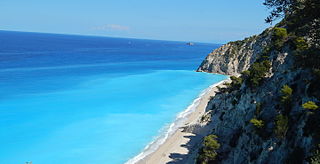
Tourism in Greece has been a key element of the economic activity in the country, and is one of the country's most important sectors. Greece has been a major tourist destination and attraction in Europe since the 1970s for its rich culture and history, which is reflected in large part by its 18 UNESCO World Heritage Sites, among the most in Europe and the world as well as for its long coastline, many islands, and beaches.

Lindos is an archaeological site, a fishing village and a former municipality on the island of Rhodes, in the Dodecanese, Greece. Since the 2011 local government reform it is part of the municipality Rhodes, of which it is a municipal unit. The municipal unit has an area of 178.9 km2. It lies on the east coast of the island. It is about 40 km south of the city of Rhodes and its fine beaches make it a popular tourist and holiday destination. Lindos is situated in a large bay and faces the fishing village and small resort of Charaki.

Athens is one of the oldest named cities in the world, having been continuously inhabited for perhaps 5,000 years. Situated in southern Europe, Athens became the leading city of Ancient Greece in the first millennium BC, and its cultural achievements during the 5th century BC laid the foundations of Western civilization.

The Perserschutt, a German term meaning "Persian debris" or "Persian rubble", refers to the bulk of architectural and votive sculptures that were damaged by the invading Persian army of Xerxes I on the Acropolis of Athens in 480 BC, in the Destruction of Athens during the Second Persian invasion of Greece.
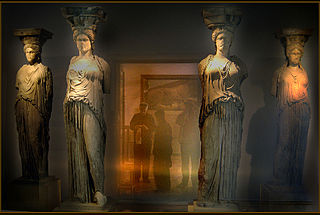
The Old Acropolis Museum was an archaeological museum located in Athens, Greece on the archeological site of Acropolis. It is built in a niche at the eastern edge of the rock and most of it lies beneath the level of the hilltop, making it largely invisible. It was considered one of the major archaeological museums in Athens. Due to its limited size, the Greek government decided in the late 1980s to build a new museum. The New Acropolis Museum is now built at the foot of the Acropolis. In June 2007 the old museum closed its doors so that its antiquities could be moved to their new home, which opened on 20 June 2009.

The Old Temple of Athena or the Archaios Neos was an archaic Greek limestone Doric temple on the Acropolis of Athens probably built in the second half of the sixth-century BCE, and which housed the xoanon of Athena Polias. The existence of an archaic temple to Athena had long been conjectured from literary references until the discovery of substantial building foundations under the raised terrace between the Erechtheion and Parthenon in 1886 confirmed it. While it is uncontroversial that a temple stood on the central acropolis terrace in the late archaic period and was burnt down in the Persian invasion of 480, nevertheless questions of its nature, name, reconstruction and duration remain unresolved.

The Acropolis Museum is an archaeological museum focused on the findings of the archaeological site of the Acropolis of Athens. The museum was built to house every artifact found on the rock and on the surrounding slopes, from the Greek Bronze Age to Roman and Byzantine Greece. The Acropolis Museum also lies over the ruins of part of Roman and early Byzantine Athens.

The Acropolis of Rhodes is the acropolis, or upper town, of ancient Rhodes dating from the 5th century BC and located 3 kilometers SW from the centre of the modern city. Situated on Monte Smith overlooking the west coast of the island, the archaeological site includes some of the most important monuments in the ancient city, such as the Temple of Athena Polias and Zeus Polieus and the Temple of Apollo, below which are a stadium, an odeon and a gymnasium. Unlike other acropoleis, no walled citadel was built here.

The Sanctuary of Zeus Polieus was a walled open-air sanctuary dedicated to Zeus Polieus around 500 BC on the Acropolis of Athens, sited to the Erechtheion's east. None of its foundations have been discovered and its trapezoid plan and many entrances have been worked out from rock cuttings on the Acropolis. The eastern area of the sanctuary is thought to have housed the oxen for the annual Bouphonia or ox-sacrificing. Its main entrance had a pediment.

The Hekatompedon or Hekatompedos, also known as Ur-Parthenon and H–Architektur, was an ancient Greek temple on the Acropolis of Athens built from limestone in the Archaic period, and placed in the position of the present Parthenon.
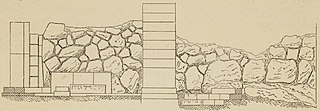
Adolf Bötticher or Adolf Boetticher was a German art historian and conservator.
Johann (Hans) Hermann Schrader was a German classical archaeologist and art historian.
The Peplos Kore is an ancient sculpture from the Acropolis of Athens. It is considered one of the best-known examples of Archaic Greek art. Kore is a type of archaic Greek statue that portray a young woman with a stiff posture looking straight forward. Although this statue is one of the most famous examples of a kore, it is actually not considered a typical one. The statue is not completely straight, her face is leaned slightly to the side, and she is standing with her weight shifted to one leg. The other part of the statues name, peplos, is based on the popular archaic Greek gown for women. When the statue was found it was initially thought that she was wearing a peplos, although it is now known that she is not.
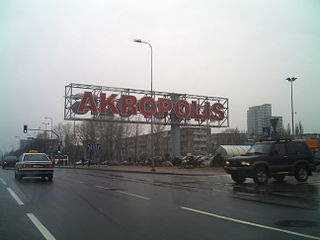
Akropolis is the biggest shopping center in Klaipėda and the sixth largest shopping mall in Lithuania with 76,410 m2. It was built by the Lithuanian company AB "Vilniaus Akropolis" in 2005. It was built Taikos pr. 61. On the side of the building there is a four-level free car park. The entertainment area featuring an Olympic-sized ice arena, several restaurants, 6 cinema halls, bowling, casinos and other entertainment venues. There are grocery stores, Maxima LT supermarket, 244 shops etc. The mall also has bookstores. Owner is AKROPOLIS GROUP, UAB.
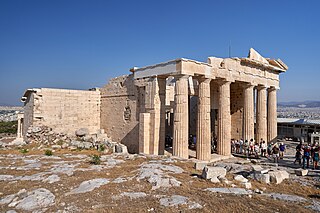
The Propylaia is the classical Greek Doric building complex that functioned as the monumental ceremonial gateway to the Acropolis of Athens. Built between 437 and 432 BCE as a part of the Periklean Building Program, it was the last in a series of gatehouses built on the citadel. Its architect was Mnesikles, his only known building. It is evident from traces left on the extant building that the plan for the Propylaia evolved considerably during its construction, and that the project was ultimately abandoned in an unfinished state.

The Temple of Roma and Augustus was a monopteral circular Ionic temple built on the Acropolis of Athens c. 19 BCE, likely coincident with Augustus' second visit to Athens. The structure was axially aligned with the eastern entrance of the Parthenon, placed 23 m (75 ft) eastward. The temple, which asserted the divinity of Rome and the Imperial cult in the context of the religious centre of the Acropolis, was a propaganda monument erected at a time of tension between Rome and Athens. Its ruins remain on the Acropolis.
The Acropolis Express was a long-distance international train that operated between Munich and Athens, named after the ancient citadel in Athens. It was a collaborative effort involving the Deutsche Bundesbahn, the Austrian Federal Railways (ÖBB), the Yugoslav Railways (JŽ), and the Hellenic Railways (OSE). The route spanned from Munich, passing through Villach, Ljubljana, Zagreb, Belgrade, Prishtina, Skopje, Thessaloniki, and reaching Athens. Designated as a D-train in Germany with the train numbers D 290/291, it held the classification of Express (Ex) in Austria and Yugoslavia.















